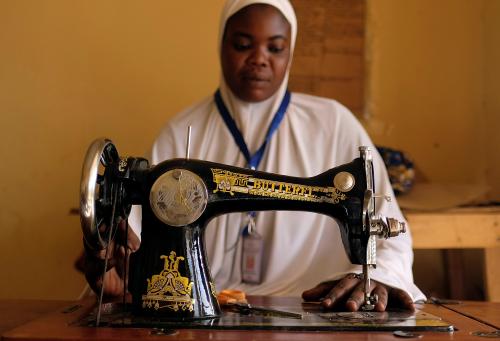Below is a viewpoint from Chapter 3 of the Foresight Africa 2018 report, which explores six overarching themes that provide opportunities for Africa to overcome its obstacles and spur inclusive growth. Read the full chapter on human development and poverty trends in Africa here.
The horrific images of African migrants drowning in the Mediterranean broadcasted live into the homes of millions of people has captivated the attention of the world in recent years, prompting many leaders to do “something about it.” These images also give the impression that Africa is a crumbling and hopeless continent from which its young and strong are so desperate they risk their lives to escape. On the other hand, economic statistics coming out of Africa describe a continent on the move with unprecedented growth and economic opportunities. Why such a paradox? To appropriately inform policies related to illegal migration from Africa, we must first understand its patterns and underlying causes.
The most important fact to note about the migration rate in Africa, is that at 2.9 percent in 2017, it is one of the lowest in the world, only higher than that of Asia and North America. Over time, the migration rate in Africa has declined while the global average rate increased from 2.9 percent of total population to about 3.4 percent (Table 3.1). Since 1990, the number of African migrants has risen by about 80 percent. This rate is among the lowest in the world, only higher than that of North America and Europe. Clearly, migration from Africa is not as widespread as is widely perceived.

The other important factor to note about the pattern of migration in Africa is that generally the bulk of it takes place within the region (Figure 3.5). In fact, 79 percent of sub-Saharan African migrants move within the same region. Less than 22 percent of migrants from Africa emigrate outside of Africa, with less than 15 percent of African migrants emigrating to Europe or North America.

Within each sub-region, we also see a pattern where, except for North Africa, the bulk of African migrants prefer to move within neighboring countries or subregions. The bulk of migrants from North Africa predominantly move to Europe, North Africa, or the Middle East.
The evidence also suggests that migrants from richer African countries tend to migrate to destinations outside of Africa.
Thus, migration from Africa generally is low by global standards, and most of the movement, except for North Africa, takes place within the region, partly reflecting the relatively more flexible migration policies adopted by African countries over the years. The evidence also suggests that migrants from richer African countries tend to migrate to destinations outside of Africa (Figure 3.6). This is not surprising. One of the determinants of migration is cost, including travel and relocation [1]. The poorer a country is, the less affordable it becomes to travel far in search of better opportunities. In addition, migrants from relatively rich origin countries tend to be better educated and skilled. Thus, the rate of migration to richer countries from Africa could be projected to increase with rising economic opportunity, education, and other factors—called the Migration Hump—and recede once the wage differential between origin and destination countries narrows sufficiently, and other non-pecuniary considerations become important to the quality of life of migrants. For instance, populist views and less-welcoming regulations in richer countries could significantly dissuade migrants from richer African countries. This comes, however, with significant cost to the global economy, particularly to countries with an aging population. For a long time, migration has been a source of a sustained supply of labor at reasonably constant wages fueling growth in many advanced countries.

Finally, migration has also served as a lifeline for many African countries through the flow of remittances. For African countries, these reliable flows have become the most important source of foreign exchange, provide consumption smoothing for poor families, and serve as a source of investment at the household level for education, assets, and other amenities. In addition, remittances serve as important factor in reducing asset inequality in Africa (Shimeles and Nabasaga, forthcoming).
In terms of policy implications, migration episodes that respond to incentives for economic opportunities generally reflect market forces in bridging excess demand in factor or goods markets, thus allowing efficient allocation of resources and fostering greater economic integration. Despite lack of evidence, it is plausible to expect that South-South migration is followed by increased trade flows and adjustment of labor markets in both sending and destination countries, which both play a crucial role in promoting growth and ensuring employment [2]. The more formal and institutionalized migration becomes, the greater economic integration and its benefits will be. The full benefit of such mobility of labor can be realized only if concerned national governments are able to jointly manage and coordinate the flow of migrants and protect basic rights for the entire duration of their stay. There are incidents of extortion, abuse, and exploitation of migrants bound to other parts of Africa as both legal and illegal migration became commercialized (Lucas, 2006; Shaw, 2007). Limited or lack of well-functioning financial intermediaries inhibit the flow of remittances, thus reducing their potential impact on household welfare. There are also a wide range of issues on property rights, licensing of businesses, and transfer of funds that African governments have not harmonized to encourage immigrants to engage in investment activities. Certainly this translates into areas of intra-African trade and investment, which has not improved much over the years. In principle, greater economic integration helps stem the flow of migration and limits its size and composition to what is allowed by economic fundamentals. The regional economic unions such as COMESA, ECOWAS, EAC, SACU, and SADC [3], have been around for the greater part of post-independence Africa and yet their effectiveness in managing migration flows is still not sufficient.
This essay is based on a revised working paper Shimeles, A. (2010), ”Migration trends, patterns and policy issues in Africa,” AfDB Working Paper series No 119.
REFERENCES
Lucas, R.E.B. (2006), “Migration and economic development in Africa: a review of evidence,” Journal of African Economies, Supplement 2, 337-395.
Rosenzwig, M. (2007), “Education and migration: a global perspective,” mimeo, Yale University.
Shaw, W. (2007), “Migration in Africa: a review of economic literature on international migration in 10 countries,” World Bank, memo.
Shimeles, A. and T. Nabasaga. “Why is inequality high in Africa,” Journal of African Economies, forthcoming.
World Bank. (2010), “Migration and Remittances Fact Book 2011,” Development Prospects Group.
footnotes
- An important element emphasized in the literature is the role that “cost of migration” plays in affecting migration flows. See for instance, Hatton and Willamson (2003) and also Rosenzwig, (2005) who showed that apart from the cost of migration, for a given level of skill price, the higher the per capita GDP of a country, the higher becomes the rate of out-migration.
- World Bank (2010) report suggests that in Southern Africa, generally wage rates follow that of South Africa with some lag for adjustment. Certainly, the degree of adjustment is better for economies that are closely integrated with South Africa.
- Respectively, Common Market for Eastern and Southern Africa, Economic Community of West African States, East African Community, Southern African Customs Union, and Southern African Development Community.






Commentary
Foresight Africa viewpoint – Understanding the patterns and causes of African migration: Some facts
January 18, 2018